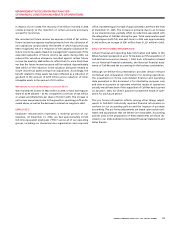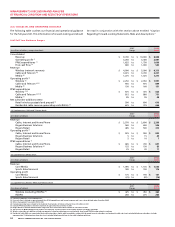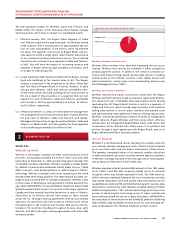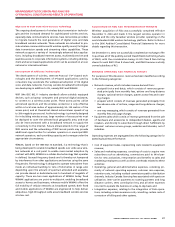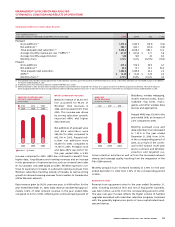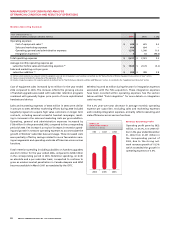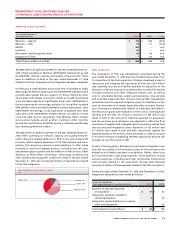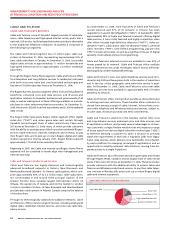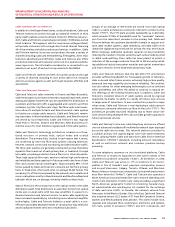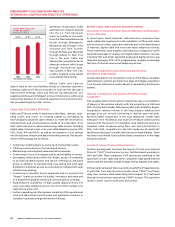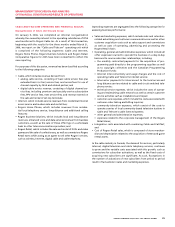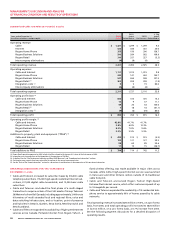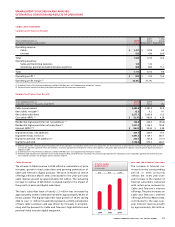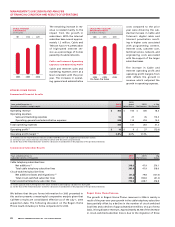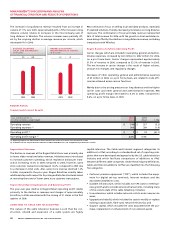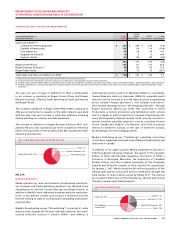Rogers 2006 Annual Report Download - page 37
Download and view the complete annual report
Please find page 37 of the 2006 Rogers annual report below. You can navigate through the pages in the report by either clicking on the pages listed below, or by using the keyword search tool below to find specific information within the annual report.
33
RO GER S CO MMU NIC AT ION S IN C . 20 0 6 ANN UA L RE POR T
MANAGEMENT’S DISCUSSION AND ANALYSIS
OF FINANCIAL CONDITION AND RESULTS OF OPERATIONS
Cable and Telecom’s Dist ribution
In addition to the Rogers Retail stores, as described above, Cable and
Telecom markets its services through an extensive network of third
party retail locations across its network footprint. Effective January 1,
2007, Cable and Telecom acquired approximately 170 Wireless-owned
retail locations. This segment, which is now known as Rogers Retail,
will provide customers with a single direct retail channel featuring
all of the wireless and cable products and services. In addition, Cable
and Telecom markets its services and products through a variety of
channels including outbound telemarketing, field agents, direct mail,
television advertising and affinities. Cable and Telecom also offers
products and services and customer service via its e-business website,
www.rogers.com. The information contained in or connected to our
website is not a part of and not incorporated into this MD&A.
Cable and Telecom markets and sells its business products through
a variety of channels including its own direct sales force, exclusive
and non-exclusive agents as well as through business affinities and
associations.
Cable and Telecom’s Networks
Cable and Telecom’s cable networks in Ontario and New Brunswick,
with few exceptions, are interconnected to regional head-ends, where
analog and digital channel line-ups are assembled for distribution to
customers and Internet traffic is aggregated and routed to and from
customers, by inter-city fibre-optic rings. The fibre-optic interconnec-
tions allow its multiple Ontario and New Brunswick cable systems
to function as a single cable network. Cable and Telecom’s remain-
ing subscribers in Newfoundland and Labrador, and New Brunswick
are served by local head-ends. Cable and Telecom’s two regional
head-ends in Toronto, Ontario and Moncton, New Brunswick pro-
vide the source for most television signals used in the cable systems.
Cable and Telecom’s technology architecture is based on a three-
tiered structure of primary hubs, optical nodes and co-axial
distribution. The primary hubs, located in each region that it serves,
are connected by inter-city fibre-optic systems carrying television,
Internet, network control and monitoring and administrative traffic.
The fibre-optic systems are generally constructed as rings that allow
signals to flow in and out of each primary hub, or head-end, through
two paths, providing protection from a fibre cut or other disruption.
These high-capacity fibre-optic networks deliver high performance
and reliability and have capacity for future growth in the form of dark
fibre and unused optical wavelengths. Approximately 99% of the
homes passed by Cable and Telecom’s network are fed from primary
hubs, or head-ends, which each serve on average 93,000 homes. The
remaining 1% of the homes passed by the network are in smaller and
more rural systems mostly in New Brunswick and Newfoundland and
Labrador which are, on average, served by smaller primary hubs.
Optical fibre joins the primary hub to the optical nodes in the cable
distribution plant. Final distribution to subscriber homes from optical
nodes uses co-axial cable with two-way amplifiers to support on-
demand television and Internet service. Co-axial cable capacity has
been increased repeatedly by introducing more advanced amplifier
technologies. Cable and Telecom believes co-axial cable is a cost-
effective and widely deployed means of carrying two-way television
and broadband Internet services to residential subscribers.
Groups of an average of 495 homes are served from each optical
node in a cable architecture commonly referred to as fibre-to-the-
feeder (“FTTF”). The FTTF plant provides bandwidth up to 860 MHz,
which includes 37 MHz of bandwidth used for “upstream” transmis-
sion from the subscribers’ premises to the primary hub. Cable and
Telecom believes the upstream bandwidth is ample to support mul-
tiple cable modem systems, cable telephony, and data traffic from
interactive digital set-top terminals for at least the near term future.
When necessary, additional upstream capacity can be provided by
reducing the number of homes served by each optical node by what
is called node-splitting. Fibre cable has been placed to permit a
reduction of the average node size from 495 to 350 homes by install-
ing additional optical transceiver modules and optical transmitters
and return receivers in the head-ends and primary hubs.
Cable and Telecom believes that the 860 MHz FTTF architecture
provides sufficient bandwidth for foreseeable growth in television,
data, voice and other future services, extremely high picture quality,
advanced two-way capability and network reliability. This architec-
ture also allows for other emerging technologies such as switched
video and MPEG4, and offers the ability to continue to expand ser-
vice offerings on the existing infrastructure. In addition, Cable and
Telecom’s clustered network of cable systems served by regional
head-ends facilitates its ability to rapidly introduce new services
to large areas of subscribers. In new construction projects in major
urban areas, Cable and Telecom is now deploying a cable network
architecture commonly referred to as fibre-to-the-curb (“FTTC”). This
architecture provides improved reliability due to fewer active net-
work devices being deployed. FTTC also provides greater capacity for
future narrowcast services.
Cable and Telecom’s voice-over-cable telephony services are offered
over an advanced broadband IP multimedia network layer deployed
across the cable service areas. This network platform provides for
a scalable primary line quality digital voice-over-cable telephony
service utilizing Packet Cable and Data Over Cable Service Interface
Specification (“DOCSIS”) standards, including network redundancy
as well as multi-hour network and customer premises backup
powering.
To serve telephony customers on circuit-switched platforms, Cable
and Telecom co-locates its equipment in the switch centres of the
incumbent local phone companies (“ILECs”). At December 31, 2006,
Cable and Telecom was active in 175 co-locations in 60 munici-
palities in five of Canada’s most populous metropolitan areas in
and around Vancouver, Calgary, Toronto, Ottawa, and Montreal.
Many of these co-locations are connected to its local switches by metro
area fibre networks (“MANs”). Cable and Telecom also operates a
North American transcontinental fibre-optic network extending over
16,000 route kilometres (10,000 route miles) providing a significant
North American geographic footprint connecting Canada’s larg-
est markets while also reaching key U.S. markets for the exchange
of data and voice traffic. In Canada, the network extends from
Vancouver in the West to Quebec City in the East. Cable and Telecom
also acquired various CLEC assets of GT from Bell Canada in Ontario,
Quebec and Newfoundland and Labrador. The assets include local,
regional and long-haul fibre, transmission electronics and systems,
GT’s hubs, points of presence (“POPs”) and ILEC co-locations, and


